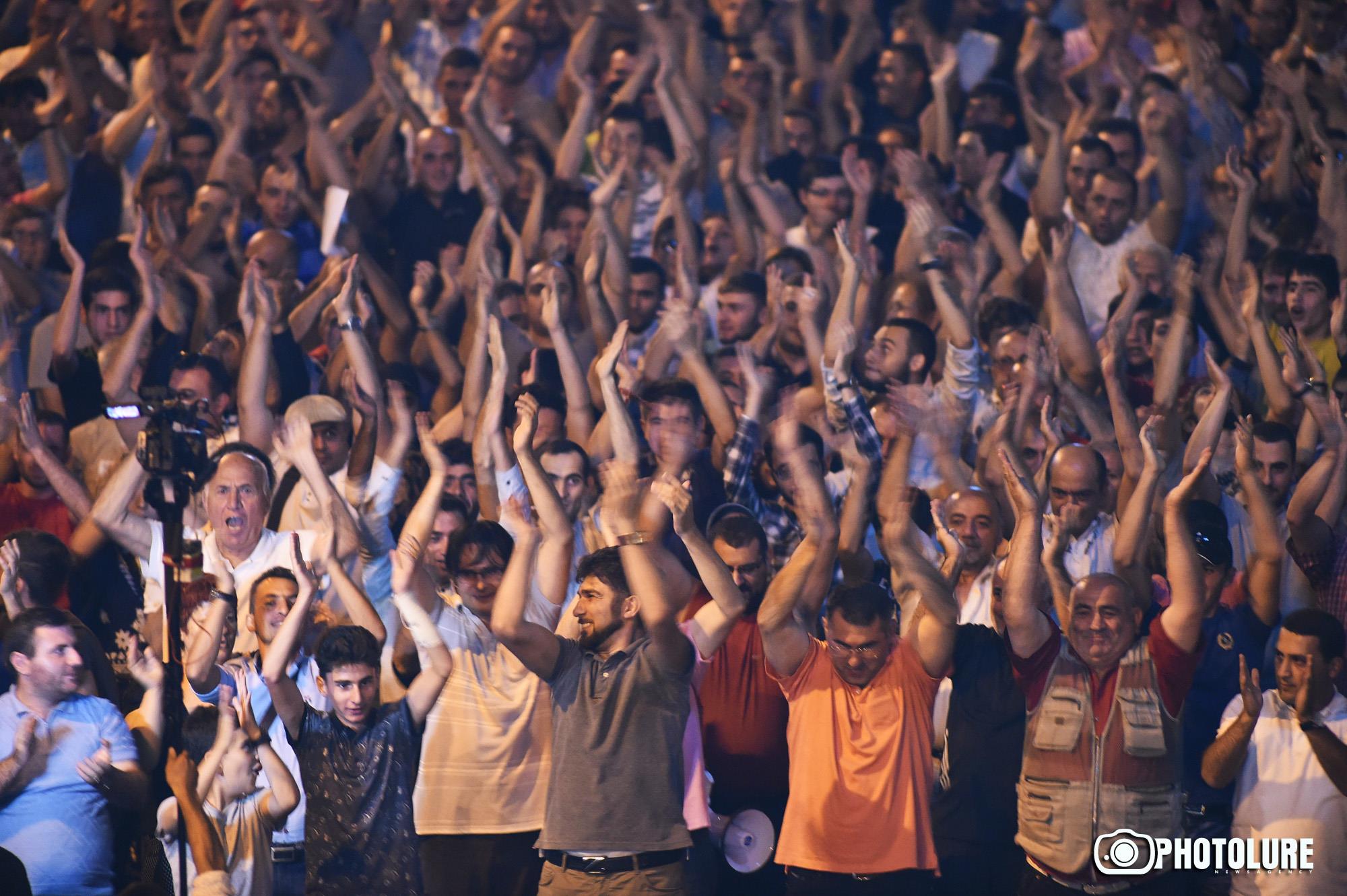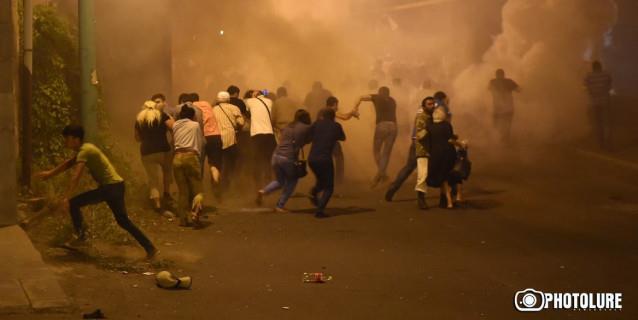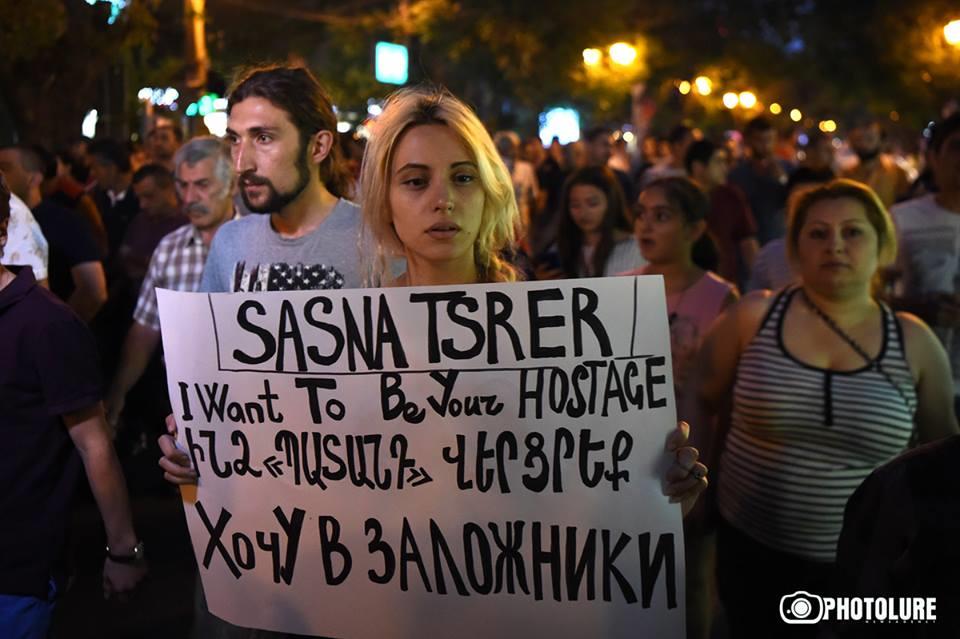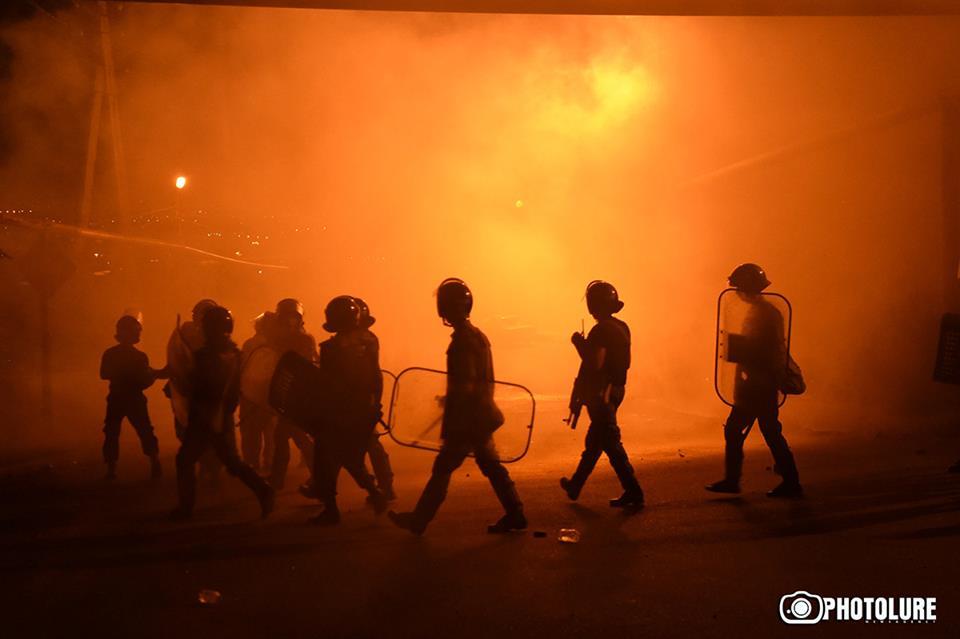Yerevan has never witnessed anything like it
On July 17, a group of armed people seized an area of the Erebuni patrol police regiment, demanding the release of Jirayr Sefilian, an oppositionist, who had been arrested one month prior. Jirayr Sefilian, the Founding Parliament leader, was arrested for the illegal procurement of, possession of and trafficking of firearms and ammunition.
On July 17, the rebels, representing the Sasna Tsrer movement, insisted that Sefilian should be brought to the seized territory, claiming they would obey only his orders. In addition to this, armed group members demanded the resignation of the Armenian President, Serzh Sargsyan. Support for group members and its demands has grown into a protest movement, which has no clear-cut leaders so far.
Chronology of developments from 2 p.m., July 29 till 2p.m., July 30, 2016
At first, the media reported that the criminal proceedings against Levon Barsegyan, the head of the Asparez press club, had been called off. Barsegyan was arrested by the police following his participation in the July 27 rally in support of the Sasna Tsrer group and its demands. He was accused of the ‘possession of cold weapons’.
As it was reported earlier on July 29, the police had examined the weapon and found out that the pocket knife, seized from the journalist, is not a cold weapon. At 4:30 p.m., while Levon Barsegyan was speaking at a news conference, recalling the details of his detention and release, there came the reports on a shooting in the seized patrol police regiment’s territory.
Varuzhan Avetisyan, a member of the armed group, told journalists that one of the Sasna Tsrer group’s members, Anaik Khandoyan (aka Lonely Wolf), was wounded by police officers. In Avetisyan’s words, there were drones flying over the regiment and Khandoyan went out to check what was coming down from the drones-whether it was a bomb or not. He was wounded by a sniper.
Varuzhan Avetisyan also told journalists that Sasna Tsrer accomplished its mission-they have gathered people into their rebellion and what they have to do now is to ensure their own security and that they have sufficient resources to deliver a serious blow against the police.
However, the two wounded members of the armed group were brought to hospital by 8 p.m., which made it obvious that Araik Khandoyan was not the only one wounded in the shootout.
Meanwhile, a traditional rally was underway on Freedom Square. Participants in the rally were demanding a change in power and the release of political prisoners, stressing that it was unacceptable to give up land in Nagorno-Karabakh and its adjacent areas. As usual, a march started following an address from the group.

The area adjacent to the seized patrol police regiment was the destination of the crowded procession. The police awaited the demonstrators there. This time they were very categorical: they warned organizers and participants alike that the rally was illegal and asked them to scatter.
Some shots could be heard from the seized regiment. No was able to figure out was going on there. Participants in the rally, however, assumed that members of the Sasna Tsrer group members were greeting them in this violent manner.
The police still insisted that the rally was illegal and gave the protestors 5 minutes to disperse. However, the organizers of the rally refused to disperse and claimed that they would do their best to prevent any conflict and provocation.
Several shots were fire around 10:30p.m., upon which many police officers immediately rushed into the crowd. They were grabbing people indiscriminately. Soon dozens of protesters had been detained. The police displayed extreme aggression, and this time they didn’t spare journalists.

They were beaten, taken into custody and their cameras and recorders were smashed. Many journalists reported, there were policemen among the civilians. Representatives of almost all the media outlets covering the developments were affected.
A JAMnews photographer’s camera was also seized and another one smashed. Therefore, the developments on July 29 are illustrated by the Photolure agency’s photos.

Arman Tatoyan, an Ombudsman, called on law-enforcers to immediately issue explanations with regard to the use of force against the journalists performing their professional duties.
Ashot Agaronyan, the Police spokesperson, was making Facebook posts in while the developments were taking place. As far as the violence against journalists is concerned, Agaroyan wrote as follows:
“Special means were used by the police against the individuals attempting to break through the security zone around the patrol police regiment. A fight broke out and, regrettably, representatives of the mass media were also affected. According to early reports, some equipment has been damaged. All cases involving media persons will be immediately investigated into, the circumstances will be cleared up and the results will be made public.
As Agaronyan also reported, one of the police officers was wounded as the result of the shooting from the seized area:
“When the protesters tried to approach the security zone and break through the barriers, several shots were fired from the seized area in different directions. A police officer, who was standing outside the patrol police regiment, was wounded and taken to the hospital.
In addition, he also stated the following: the rumors about an ongoing special operation in the seized territory, involving foreign snipers, who have allegedly been specially invited for this purpose, are not true.
As police officials stated on the number of occasions during the rally, the operation was conducted to protect citizens. But the citizens’ response was this: it’s high time to protect the citizens against the police themselves.

According to early data from the Health Ministry, 60 people were admitted to hospitals in Yerevan. Four of them are reported to be in critical condition.
Thorbjørn Jagland, the Secretary General of the Council of Europe, expressed concern about the hostage crisis in Armenia: “I call on all those concerned to put an end to this dangerous situation without any delay, and to return to the use of democratic means. The conflict should be solved within the framework of a political dialogue.
Nikol Pashinyan, MP, wrote on his Facebook page that night: “I strongly condemn the police officers’ illegal actions against the peaceful demonstrators and journalists. I call on the police to to explain their actions with regard to the individuals among the civilians, who went through the police cordon into the protestors’ ranks and provoked the clashes.
On social media
Few people slept in Yerevan that night. Many were discussing the recent developments on Facebook. The majority of Facebook users were outraged by the violence against journalists.
Trend 1: The incident should be condemned and the guilty should be punished
“I can’t calm down. Those responsible for the use of brutal force against journalists should pay the price for it. Who is going to compensate them for the moral and material damage – for their backs which were broken by batons; for their faces, hands and feet which burned by the pellets; for their damaged photo and video cameras. I am dead sure no one will!
Trend 2: It was a pre-planned campaign against journalists
“It was not a mere breakup of the protest rally. They were settling old scores. It can be compared to disruptions of rallies in other places. A rally is never broken up when it is a trap.
Trend 3: The authorities have discredited themselves once for all
“As far as I understand, a government resignation will hardly be enough for people. Now there is a need for judicial proceedings and an investigation into the crimes committed against the nation.
“Only 5 or 6 out of 131 MPs are likely to condemn this incident; the rest of them are on vacation. The National Assembly, beg your pardon, the National Corpse with all your parties, how many more wounded are needed to make you finally say something?
Expert opinion
Sergey Minasyan (Deputy Director of the Caucasus Institute) expressed his opinion on how the existing situation could be resolved:
“The first option that the majority of armed group supporters surely hope for, but which is less realistic, is a peaceful-though actually not so peaceful-change in power that is unlikely to turn Armenia into a new Switzerland, but may bring it onto the verge of an active civil confrontation and even a civil war…
The second option is far more realistic, but less optimistic for what the public expects in Armenia. The authorities will ‘straighten out’ this situation more or less without bloodshed (or at least with a minimum amount of losses). Afterwards, some of these expectations will be met, for example, the president’s resignation; some new faces at different levels in the executive and, within a year, in the legislative branches of government; certain reforms in the socio-economic sphere, as well as in the defence and security field. The community will still be discontent, but it will tolerate all of this with the hope of better days ahead deep in its heart.
However, as likely as not, even if the authorities manage to settle this situation, the more realistic but less optimistic action will be the third option, under which the authorities won’t draw any particular conclusions, will carry out some reforms as a façade. The government will be reshuffled, but there won’t be any substantive socio-economic, political or staff changes.
As a result, it can be expected that similar events, involving some other people, may occur again after a certain period of time… “
Published: 30.07.2016


















